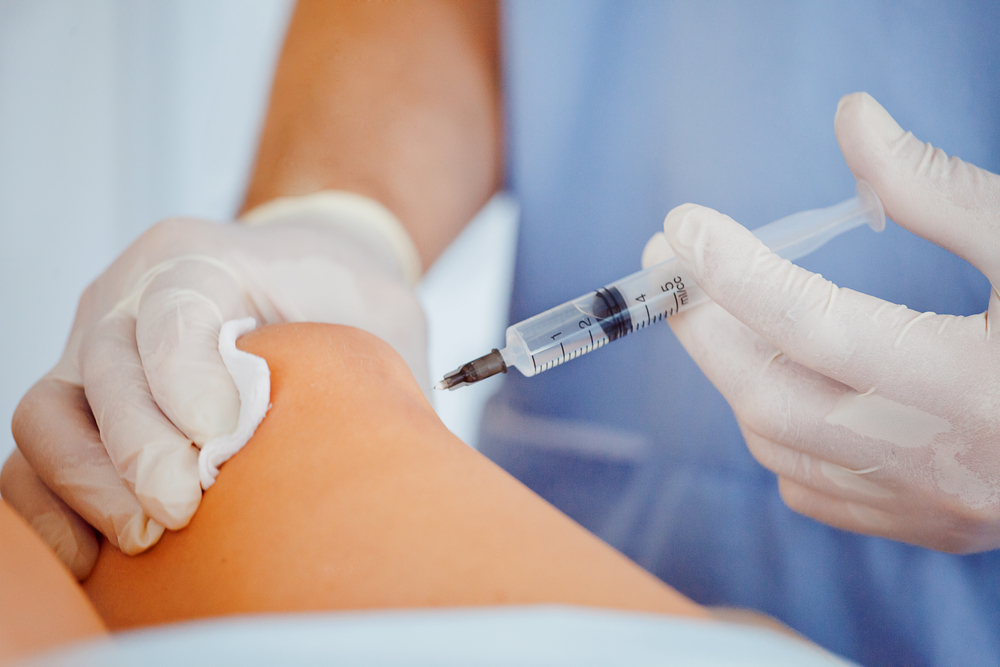Arthritis is a common condition that affects nearly a quarter of Americans. It can cause debilitating pain, making it hard for people to work or enjoy everyday activities like exercising, cooking, and socializing. Researchers project the number of people with arthritis to rise considerably in the coming decades.
Osteoarthritis is the most common form of arthritis and occurs when the joint cartilage breaks down. It’s one of the leading causes of disability worldwide, affecting 7% of the global population.
Joint issues can be hard to treat because naturally they have a poor blood supply and do not heal as well as other tissues. Unfortunately, conventional treatment options aren’t optimal and can cause serious issues.
Cortisone injections are a standard treatment option for osteoarthritis and other joint-related pain. Cortisone treatments do help to reduce pain and inflammation significantly but only for a couple of months.
Eventually, the effects wear off, and repeated doses are often required. Over the long term, this can corrode and damage the joint tissue, worsening the condition. In addition, recent studies have uncovered other health risks, which we’ll cover below.
Despite mounting evidence of the dangers of high-dose cortisone injections, doctors continue to administer them. Most people, including doctors, simply aren’t aware that there are better alternatives to cortisone injections. Instead of causing tissue breakdown, these treatments help rebuild tissue, reversing the effects of degenerative processes associated with arthritis and injury.
Injecting cortisone into a joint doesn’t address the root causes of the pain and inflammation. Instead, it’s a “band-aid” approach that only alleviates the symptoms. The focus of care should be on facilitating the healing of the joint to make it stronger and healthier.
Let’s examine why you should avoid cortisone injections and which alternative treatments are most effective.

The dangers of cortisone injections
While cortisone injections can relieve short-term pain and reduce inflammation in swollen and inflamed joints, they carry significant long-term risks.
Joint damage and worsening arthritis
A recent review by radiologists from the Boston University School of Medicine found that cortisone injections were associated with an increased risk of:
- increased osteoarthritis progression
- Stress fractures
- Osteonecrosis (bone cell death from lack of blood flow)
- Rapid destruction of the joint, including bone loss
The study’s authors agreed that doctors should provide their patients with information regarding the potential complications of cortisone injections before the patient agrees to such treatments. Unfortunately, this is not the case currently. Instead, most patients have no idea of the risks cortisone treatments carry.
Two recent studies provided further evidence that cortisone is ineffective and can make osteoarthritis worse.
In one study, researchers compared the joints of 44 osteoarthritis patients who received cortisone injections to 140 patients who didn’t receive any injections. MRI scans found that only the patients who received cortisone injections saw their osteoarthritis worsen over two years.
“While…corticosteroid…injections are reported to help with symptomatic pain relief for knee osteoarthritis, our results conclusively show that corticosteroids are associated with significant progression of knee osteoarthritis up to two years post-injection and must be administered with caution.”
Dr. Upadhyay Bharadwaj, lead author
The second study had similar findings. In this study, researchers looked at 50 osteoarthritis patients given cortisone injections and 50 patients without. They looked at X-rays of the patients’ joints at baseline and then compared them two years later.
The researchers found that patients who had cortisone injections had more significant progression of their osteoarthritis, even though both groups’ joints looked similar at baseline.
“Even though imaging findings for all patients were similar at baseline, the imaging hallmarks of osteoarthritis were worse two years later in patients who received corticosteroid injections compared to…no treatment at all.”
Azad Darbandi, lead author
Darbandi also added that cortisone injections should be used with more caution than they currently are.
When used too often, cortisone injections can disrupt the body’s natural ability to regenerate and repair damaged tissue, causing the cartilage and other body parts to break down faster. So, the more injections you get, the more damage you do to your joints, causing further pain and increasing the chance you require surgery to replace or repair the affected joint.
Increased infection risk
Cortisone injections also increase the risk of infections before and after knee replacements.
Cortisone works by suppressing the immune system, allowing opportunistic bacteria to thrive. As a result, joint infections can be hard to treat and may require long courses of antibiotics or further surgeries.
Other side effects
Beyond causing tissue damage and bone loss and increasing the risk of infections and stress fractures, cortisone has many side effects. These include:
- Blurred vision, eye pain, or trouble reading
- Dizziness
- Headache
- Irregular heartbeat
- Numbness or tingling in your arms or legs
- Pounding in your ears
- Shortness of breath
- Bone loss
- High blood sugar
If cortisone treatment carries so many risks and side effects, why do orthopedic doctors rely on it? Unfortunately, many doctors fail to keep up with the recent research highlighting the dangers of cortisone.

Alternatives to cortisone injections
Cortisone injections aren’t the best solution to address arthritis and joint-related pain because they don’t do anything to address the underlying cause of the pain and inflammation.
While the body has an innate ability to regenerate damaged tissue, it’s limited in its capacity. Regenerative therapies support and even enhance the body’s natural healing ability. Let’s look at these regenerative treatments and see why they’re safer and more effective than cortisone injections.
Prolozone
Prolotherapy is a regenerative treatment that stimulates the body’s natural repair mechanisms.
It involves injecting an irritant as a solution mixed with salt or sugar into the joint. The irritant triggers the body’s innate healing process to help restore tissue function and integrity as well as reduce pain. Research shows that prolotherapy supports improvement in mild to moderate osteoarthritis.
Our clinic uses a similar therapy called prolozone that combines prolotherapy and ozone gas to enhance the effects of both therapies. Ozone is a set of three oxygen atoms bonded together that helps improve blood flow when delivered to injured tissue.
Prolotherapy with ozone is a much more powerful stimulator of healing. By triggering the body’s innate healing response and simultaneously boosting circulation and oxygen utilization, prolozone delivers exceptional results.
Some patients see improvement after a single prolozone session, but most require multiple treatments to see lasting improvement in their symptoms. The great news is that prolozone has virtually no recovery time, and most patients can resume their daily activities the following day.
Platelet-Rich Plasma Therapy (PRP)
Platelets are tiny cells in the blood that help form clots. They also play a vital role in inflammation and tissue healing.
When cells become damaged, platelets release chemicals called cytokines that instruct special immune cells to come to help repair the damage.
Platelet-rich plasma (PRP) therapy is a type of treatment that involves using blood enriched with platelets to accelerate the repair of joint tissue, including cartilage. The blood is taken from the patient and quickly spun in a machine to remove red and white blood cells, mainly leaving platelets behind. It’s then injected into the joint to reduce inflammation and facilitate joint tissue healing.
A review of 24 studies using PRP therapy for treating knee osteoarthritis symptoms found that it was more effective in reducing pain and improving joint function than cortisone injections.
Our team combines ozone with PRP therapy to enhance tissue repair and reduce pain. Combining ozone with PRP results in a synergistic healing effect more significant than either therapy alone.
In a study of patients in the early stages of osteoarthritis, those who received PRP along with ozone had less pain and inflammation, recovered faster, and had better physical function than those who received just PRP.
Stem Cell Therapy
Stem cells are unique cells that can become almost any cell type in the body. Stem cells are found throughout the body but are more concentrated in some tissues than others.
Stem cell therapy uses these cells to help repair damaged joints by supplying the joint with raw materials needed to rebuild cartilage and other joint tissue.
This process involves harvesting stem cells, concentrating them, and injecting them into the affected joint.
While stem cell therapy is relatively new, it has shown promising results in regenerating joint tissue, reducing inflammation, and relieving pain in osteoarthritis patients.

Let’s recap
Cortisone shots are a short-term solution that carries considerable risks. Although they may temporarily take away most of the pain, they may accelerate the damage and destruction of your joints. They may also increase your risk of infection before or after joint replacement surgery by suppressing your immune system.
Alternative treatments, including prolotherapy, PRP therapy, and stem cell therapy, are safer and more effective than traditional cortisone injections and are worth considering.
If you’re interested in harnessing your body’s natural regenerative abilities to restore joint health and relieve pain, schedule an appointment with our team.
References
- Kompel AJ, Roemer FW, Murakami AM, Diaz LE, Crema MD, Guermazi A. Intra-articular corticosteroid injections in the hip and knee: perhaps not as safe as we thought? Radiology. 2019;293(3):656-663. https://pubs.rsna.org/doi/10.1148/radiol.2019190341?url_ver=Z39.88-2003&rfr_id=ori:rid:crossref.org&rfr_dat=cr_pub%20%200pubmed
- Hootman JM, Helmick CG, Barbour KE, Theis KA, Boring MA. Updated projected prevalence of self-reported doctor-diagnosed arthritis and arthritis-attributable activity limitation among U.S. adults, 2015–2040. Arthritis Rheumatol 2016;68:1582–7. https://doi.org/10.1002/art.39692
- Hunter DJ, March L, Chew M. Osteoarthritis in 2020 and beyond: a Lancet commission. Lancet 2020;396:1711–2. https://doi.org/10.1016/S0140-6736(20)32230-3
- Wernecke C, Braun H, Dragoo JL. Orthopedic Journal of Sports Medicine. The Effect of Intra-articular Corticosteroids on Articular Cartilage. 2015;3(5): 2325967115581163. https://www.ncbi.nlm.nih.gov/pmc/articles/PMC4622344/
- Lai Q, Cai K, Lin T, Zhou C, Chen Z, Zhang Q, Clinical Orthopaedics and Related Research. Prior Intra-articular Corticosteroid Injection Within 3 Months May Increase the Risk of Deep Infection in Subsequent Joint Arthroplasty: A Meta-analysis. 2022; 480(5):971-979. https://pubmed.ncbi.nlm.nih.gov/34919065/
- Roeker Z, Quinlan ND, Browne JA, Werner, BC. Risk of Periprosthetic Infection Following Intra-Articular Corticosteroid Injections After Total Knee Arthroplasty.Journal of Arthroplasty 2020; 35(4):1090-1094. https://pubmed.ncbi.nlm.nih.gov/31813813/
- Rabago D, Bobby N. Prolotherapy for Osteoarthritis and Tendinopathy: a Descriptive Review. Current Rheumatology Reports. 2017;19(6):34. https://pubmed.ncbi.nlm.nih.gov/28484944/
- Sax OC, Chen Z, Mont MA, Delanois RE. The Efficacy of Platelet-Rich Plasma for the Treatment of Knee Osteoarthritis Symptoms and Structural Changes: A Systematic Review and Meta-Analysis. Journal of Arthroplasty. 2022;37(11):2282-2290. https://pubmed.ncbi.nlm.nih.gov/35537610/
- Zhu C, Wu W, Qu X. Mesenchymal Stem Cells in Osteoarthritis Therapy: A Review. American Journal of Translational Research. 2021;13(2): 448–461. https://www.ncbi.nlm.nih.gov/pmc/articles/PMC7868850/






